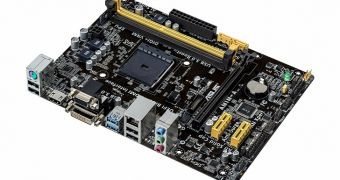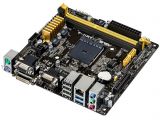The FS1b CPU socket, now called AM1, has been getting quite a bit of attention recently, as every other AMD OEM is releasing one or more motherboards that support it. Here we will be taking a look at the two mainboards from ASUS.
Named AM1M-A and AM1I-A, they are essentially called after the socket itself and the form factor they have been created in.
So, that means that the former is a micro-ATX platform (small, but not overly) and the latter is a mini-ITX mainboard.
Due to the sizes, the newcomers have some differences in terms of I/O support (input/output) and the number of PCI Express slots (mini or otherwise).
They are both equally good choices for HTPCs though (home-theater personal computers), as well as any other mini PC used today, nettops in particular (small systems that ship with the case, mainboard and I.O but no storage, memory or processor).
But we digress. The ASUS AM1M-A and AM1I-A both feature high-quality solid-state capacitors and corrosion-resistant input/output (I/O) shields. These things should maximize reliability and durability.
They also get UEFI BIOS, which means that the BIOS has a comprehensive graphical interface and can be manipulated with the mouse.
You can even use shortcuts and favorites, to quickly access whatever options you are most interested in.
Then there's the AI Suite 3, an ASUS dashboard-style control panel which you can use to modify everything about the new platforms, from PCI lanes to internal/external connections and the like.
AI Suite 3 is exclusive to ASUS, the company felt it necessary to mention, but we are pretty sure all mainboard makers have something similar. It's just unclear if they use those technologies/software on entry-level motherboards like these two.
The AM1M-A and AM1I-A also receive ASUS DIGI+ VRM (voltage-regulator module) and overcurrent protection (prevents short circuits from damaging the RAM). Electrostatic-discharge (ESD) guards are part of the spec sheet too.
Furthermore, the motherboards have USB 3.0 with UASP mode (for even faster USB 3.0 transfers than usual).
Add to that all the capabilities that the Athon/Sempron SoC APUs will bring in (R Series DirectX 11.1 graphics, Fusion controller hubs) and you should be able to build some really decent, even powerful, systems. Only the AM1M-A has a full-size PCI Express slot though.
Finally, the ASUS AM1M-A and AM1I-A have LAN, two SATA III ports (SATA 6.0 Gbps), two DDR3 memory slots, two USB 3.0 connectors, three video outputs (HDMI, DVI, VGA), and PS/2 support (oddly enough, the micro-ATX one has one and the mini-ITX one too).

 14 DAY TRIAL //
14 DAY TRIAL // 
